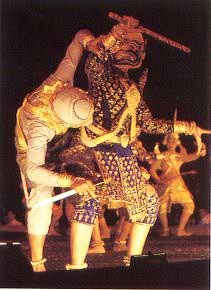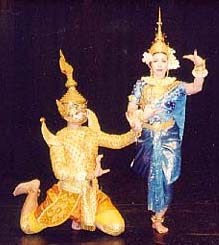Dance Spectacles
photographed by Sok Sothy
Classical Cambodian dance is comprised to two types of dances such as robam ('pure dance pieces') and roeung ('dance dramas'). Currently Classical Cambodian dance is currently composed of 60 robam and 40 roeung. Robam traditionally served as a source of entertainments, certain rituals such as robam boung soung ('dance to the heavenly deities and spirits') that would be perform to promote fertility, induce the rains, bring peace and prosperity to the kingdom. Robam chhun por ('blessed dance' or 'the best wish dance') would be performed to welcome and honour visiting head of state and to bless the nation. In dance dramas, the actresses mime the actions as an offstage choir of male and female singers delivers the text to the accompaniment of the pin-peat orchestra. The stories that performed include episodes from the Reamker (Khmer version of the Indian epic Ramayana), Preah Chinnavong tale of Prince Chinnavong, Moni Mekhala and Ream Eyso, the battle between the water goddess and the storm spirit, the Javanese Panji cycle, Preah Sang the conch prince, Monora the half woman half bird and many other local legends. The typical tales focuses on the battle between good and evil and the struggle of the noble hero with a giants who are villians for the love of a woman. An episode from the Reamker that of great popularity is the story of Sovann-Machha (the golden mermaid) who is courted by Hanuman, Preah Ream's (Prince Rama's) monkey general. Traditionally dancers were trained in the palace and performed when they were required by the king and commoners were not normally allowed to view these presentation. However times have changed and Classical Cambodian dance gone beyond the walls of the royal palace to the outside public and to the world.
|
| Robam Apsara (Celestial Nymphs Dance) this dance represents Khmer art in it's fullest form. The apsaras became a predominant feature of Angkorean art during the Khmer civilisation in the early 9th century that continued until the 15th century A.D. Apsaras were carved in their thousands on temple walls and bas-reliefs in and around Angkor. The best examples are from Angkor Wat where the seductive nymphs have that divine smile and dressed in their ancient regalia's. | |
Robam Apsara (Celestial Nymphs Dance) |
The apsaras according to legend were born from the Churning of
the Milk Sea the Hindu version of creation and said to be the wives of divine musicians.
While another legend tells of the union between an old hermit named Kampu and an Apsara
by the name of Mera, who is dressed in white representing purity help founded the
kingdom of Kampu-Mera or Kampuchea (Cambodia). In Apsara Mera's hands and
the hands of her maids they hold golden flowers that represents peace to all mankind
dancing in the celestial garden.
|
|
Roeung Reamker (Ramayana Dance Drama) is an epic tale about Preah Ream (Prince Rama) and how he was heir to his fathers throne. However Preah Ream's step-mother wanted her son to be next in line to the throne. Preah Ream was exiled to go and live in the forest for fourteen years with his wife Neang Seda (Sita) and his brother Preah Leak (Laksmana). Later on Neang Seda was abducted by Krong Reap (Ravana) king of the giants who lives on the island of Lanka. Preah Ream raises an army of monkeys aided by Hanuman and defeats Krong Reap in battle and was reunited with his beloved wife Neang Seda. Preah Ream unsure and about Neang Seda's fidelity made her take a few major tasks she was aided by Hanuman and eventually she passed. Yet still unsure he banished her from the kingdom. There she lived with an old hermit and bore two of Preah Ream's sons. Hearing the news he once again returned Neang Seda to live in the palace and he recognise Neang Seda as his wife and his two sons.
|

Roeung Reamker (Khmer version of the Ramayana) Preah Ream's monkey troops locked in battle with Krong Reap's Giants. |
Robam Ream Laksmi neng Chupa Laksmi ( Rama Laksmi and Chupa Laksmi Dance)
|
Robam Ream Laksmi neng Chupa Laksmi (Rama Laksmi and Chupa Laksmi Dance) is a dance that is strictly performed by young children. This dance is an extract from the Reamker where Preah Ream's (Prince Rama) two son ride on Preah Ream's white horse which is performed by a male dancer, and how they defeated Hanuman in series of battle with the conclusion of Hanuman being tied to a tree and leaving him there to struggle and eventually up-rooting the tree. Therefore bringing Hanuman's down fall. |
Roeung Preah Chinnavong (Prince Chinnavong Dance Drama) is about Preah Chinnavong who sees a girl walking in the garden. He falls in love with her and promises to marry her. To prove his love he gives her a rare flower, but she doesn't believe him. While he goes to find more flowers, she leaves, weeping and distraught, he vows to search for her and again promises to make her his wife. This is just one of the typical dance dramas and is quite popular in Khmer literature. Told over time and time again as well as being performed for centuries. Yet this dance is still a spectacle to watch as the traditional courting gestures are represented in it's finest movements. |
Roeung Preah Chinnavong ( Prince Chinnavong Dance Drama)
|
Robam Plett (The Fance Dance)
|
Robam Plett (The Fance Dance) was created in order to glorify the king for all the glory and grace in governing his kingdom (Cambodia). The people sing and praise the king for his love, care and concern in regards to the population and to bring peace and prosperity to the whole kingdom. Praying to the gods to bless the king and that he shall reign forever. |
| Roeung
Moni Mekhala (Moni Mekhala Dance Drama) this dance drama is about Moni
Mekhala the water goddess and Ream Eyso the storm spirit. According to legend Ream
Eyso wanted Moni Mekhala's crystal ball because it was a powerful talisman. He
tries flattery but she will have none of that. Ream Eyso declares war on Moni
Mekhala, so the battle began. Moni Mekhala with her precision blinded Ream
Eyso making his attacks very clumsly. Ream Eyso in a fit of rage produces is
magical battle axe. He clumsly aims and throws his battle axe always missing her by a
great shot. One says every time you hear thunder in the heavens it's because Ream
Eyso's battle axe clatters as it hits Moni Mekhala's crystal ball because us
mortals are only allowed to see thunder and rain while the battle is taking place in the
heaven. In the battle he always looses and vowed for revenge. This dance is also performed
to induce the rain when the land is dry and the people will pray for rain.
|

Roeung Moni Mekhala ( Moni Mekhala Dance Drama) |
Robam Monorsanchettana (Sentimental Expression Dance) performed by Ken Kunthea and photographed by Eric Vander Borght
|
Robam Monorsanchettana (Sentimental Expression Dance) is a more recent creation choreographed by the late Dance Master Chea Samy in the 1980s. The piece was originally created to provide dance students with a wide range of expressions and sentiments. It has also been performed by professional dancers as an addition to their repertoire of court dances. Theme depicts courting actions and, at its close, the sadness brought about by the separation of two lovers. |